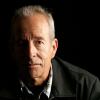John Jorgenson at Grammy Museum’s night of ‘Great Guitars’
This article was originally on a blog post platform and may be missing photos, graphics or links. See About archive blog posts.
Guitarist John Jorgenson gave Grammy Museum officials a special challenge during his question-answer-performance session Monday night: how to shoehorn the myriad aspects of an extraordinarily multifaceted career into the usual two-hour time slot and leave any time at all for him to actually play some music.
Interviewer Scott Goldman, head of the Recording Academy’s MusiCares Foundation, did a yeoman’s job of steering the conversation through Jorgenson’s upbringing in Redlands, his years honing his skills as an instrumentalist playing in three Disneyland house bands by day while moonlighting in a new wave band that was slogging it out in Hollywood clubs by night and on weekends, his role as a founding member of the country-rock Desert Rose Band in the ‘80s, his six years touring with Elton John in the ‘90s and his passionate advocacy over the years for the Gypsy jazz guitar music of Django Reinhardt.
Jorgenson, 54, touched on the highs -- in 2005, he became the first American musician to headline the annual Reinhardt tribute concert in France in the town where Reinhardt lived out the final years of his life -- and the lows: appearing once with the Desert Rose Band at a show in Mississippi, second-billed to a wrestling bear.
He remained humble to a fault about his exceptionally wide-ranging skills: Not only is he one of the most respected guitarists in the world in jazz, rock, country and bluegrass circles, but he’s also a top-notch mandolinist and clarinetist to boot. Tossed off as an aside, Jorgenson alluded to the scholarship he once was awarded as a jazz bassist.
Goldman, in fact, ran out of time to even mention the pair of Reinhardt-inspired albums Jorgenson released last year to mark the 100th anniversary of the Gypsy jazz master’s birth -- “One Stolen Night” and “Istiqbal Gathering” -- or Jorgenson’s contributions not just as a skilled performer of that style but also as a composer whose original music is adding new material to the repertoire of the expanding universe of Gypsy jazz players worldwide.
Fortunately, there was time for Jorgenson to play. The audience assembled in the Grammy Museum’s 200-seat Clive Davis Theater for the evening got a bonus in the guest appearance by Jorgenson’s Desert Rose Band cohort Chris Hillman.
“I have to say that John is the best musician I have ever played with, and I have played with some pretty interesting characters,” Hillman said, referring to the likes of Roger McGuinn and David Crosby, with whom he played in the Byrds; Gram Parsons (the Flying Burrito Brothers); Stephen Stills (Manassas); J.D. Souther and Richie Furay (the Souther-Hillman-Furay Band).
Hillman and Jorgenson served up duo versions of a couple of Hillman-penned Byrds chestnuts -- “Have You Seen Her Face” and “Time Between” -- and an old Merle Travis number that showcased not just Jorgenson’s dexterity on acoustic and electric guitars and mandolin, but also their sibling-close harmony singing.
Then Jorgenson brought up guitarist Jeffrey Radaich (subbing for Jorgenson’s former bandmate Gonzalo Bergara, who called in sick with food poisoning) to accompany him on Reinhardt’s melancholy “Nuage,” on which he demonstrated how Reinhardt managed such effortless melodic flurries despite the fact that he had lost the use of two fingers on his left hand.
It was a stellar entry in the museum’s ongoing series fittingly dubbed “Great Guitars,” which previously has featured Richard Thompson, Lee Ritenour, George Thorogood and Jonny Lang.
-- Randy Lewis
